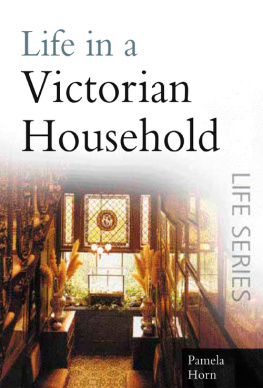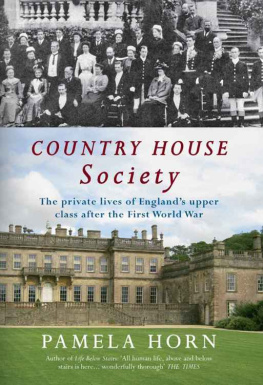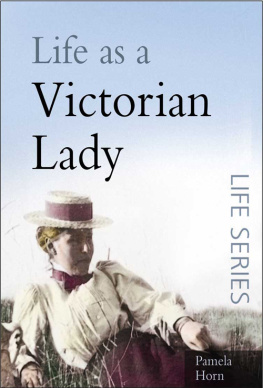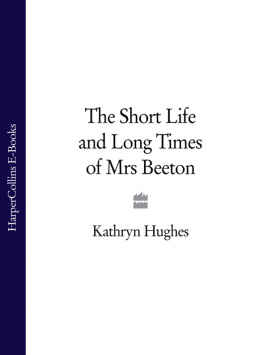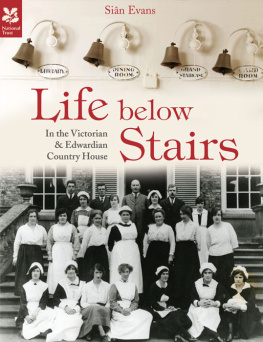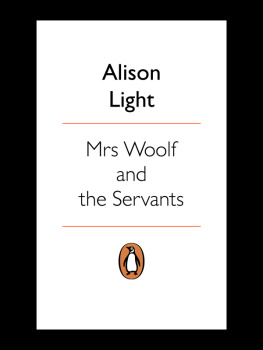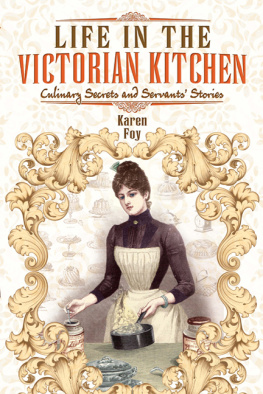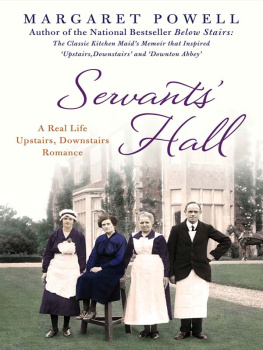Life In a Victorian
Household
First published in 2007
The History Press
The Mill, Brimscombe Port
Stroud, Gloucestershire, GL 5 2 QG
www.thehistorypress.co.uk
This ebook edition first published in 2011
All rights reserved
Pamela Horn, 2007, 2011
This ebook is copyright material and must not be copied, reproduced, transferred, distributed, leased, licensed or publicly performed or used in any way except as specifically permitted in writing by the publishers, as allowed under the terms and conditions under which it was purchased or as strictly permitted by applicable copyright law. Any unauthorised distribution or use of this text may be a direct infringement of the authors and publishers rights, and those responsible may be liable in law accordingly.
Pamela Horn has asserted the moral right to be identified as the author of this work.
EPUB ISBN 978 0 7524 7063 4
MOBI ISBN 978 0 7524 7064 1
Original typesetting by The History Press
Life In A
Victorian
Household
Pamela Horn
Contents
To my husband,
who has helped in so many different ways.
SHILLINGS AND PENCE CONVERSION TABLE
| Old money | Decimal |
| 1d | p |
| 2d or 3d | 1p |
| 4d | 1p |
| 5d | 2p |
| 6d | 2p |
| 1s | 5p |
| 1s 1d | 5p |
| 1s 1d or 1s 3d | 6p |
| 1s 6d | 7p |
| 1s 8d | 8p |
| 1s 9d or 10d | 9p |
| 1s 11d | 9p |
| 2s | 10p |
| 2s 6d | 12p |
| 3s | 15p |
| 5s | 25p |
| 10s | 50p |
| 20s | 100p i.e. 1 |
CHAPTER 1
Middle-class Victorian Homes
When Seebohm Rowntree conducted his social survey of the people of York in 1899 he took the keeping or not keeping of domestic servants... as marking the division between the working classes, and those of a higher social scale.A large proportion of the maids worked in households with one or two domestics only, around three-fifths of the nations servant-keepers falling into this category. Among them were artizans and small shopkeepers, like the Bethnal Green woman who employed a ten-year-old girl in the mid-1860s to look after a baby and to serve in the shop. When she was thirteen the girl went to another small London household, where she had a good mistress and plenty of food but had to sleep in a basement kitchen. This swarmed with black-beetles and made her very wretched at night. She also had little free time, being allowed out on Sundays only to go to church. She left after a year.
However, most domestic staffboth male and femaleworked in more substantial middle and upper class homes than these, even when they were the sole helper in the house.
The Victorian middle classes have been called the most home-centred group in British history. Charles Dickens in his Sketches of Young Couples (1840) claimed that a love of home and the English virtues associated with it provided the only true source of domestic felicity. As society became increasingly industrialized and commercialized, and as growing numbers of the population lived in towns, the home came to be seen as a refuge from the competitive pressures of the wider world. In 1801 around one in five of the 9 million people living in England and Wales were urban dwellers. By 1901, with a total population of 32.5 million, that proportion had swollen to four out of every five residing in towns. Significantly, out of the 32.5 million, around 1.3 million were domestic servants in private households1.28 million of them women and girls.
Houses came to be seen almost as personal kingdoms, protected from intrusion by those who were not family and friends by the gates, hedges and walls that marked their boundaries. Within this setting, the home served as a focus for entertainment and recreation, as well as for rest and recuperation, particularly for the menfolk when they returned from the daily demands of business or professional life. Outside the house, the gardens of the more affluent became showcases for plants, with carefully cultivated flower beds, and fruit and vegetables grown for the table. Some had hothouses, which enabled more delicate or exotic plants to be raised. Gardens were places for relaxation, too, with afternoon tea served on the lawn, croquet and archery contests organized, and impromptu games played by the children. As the Registrar-General put it, in connection with the 1851 census of population: The possession of an entire house is... strongly desired by every Englishman; for it throws a sharp, well-defined circle round his family and hearththe shrine of his sorrows, joys, and meditations.
That view was shared by John Ruskins father, the founder of a prosperous London wine firm, when he declared in sentimental mode: Oh! how dull and dreary is the best society I fall into compared with the circle of my own Fire Side with my Love sitting opposite irradiating all around her, and my most extraordinary boy.
In reality, much of family life did not match this optimistic picture. For many individuals, the intimate daily contacts and close relationships proved stifling and led to quarrels and unhappiness, as John Ruskins own unfortunate marriage was to demonstrate. Single daughters at home, especially as they grew older, often found the restrictions irksome. In the early l830s, when Florence Nightingale was in her early thirties, she expressed this general discontent, complaining of the role expected of well-todo women like herself, and the lack of purpose in their lives: They are taught from their infancy upwards that it is a wrong, ill-tempered, and a misunderstanding of womans mission... if they do not allow themselves willingly to be interrupted at all hours... The actual life is passed in sympathy given and received for a dinner, a party, a piece of furniture, a house built or a garden laid out well, in devotion to your guests... in schemes of schooling for the poor... The time is come when women must do something more than the domestic hearth.
Nonetheless, those darker aspects did not prevent society from emphasizing the centrality of family life for the nations wellbeing. That applied to all classes and in reinforcing the philosophy, religion played its part, through the values and moral standards it imparted and the sense of community which membership of a church or associated religious body engendered. F. M. L. Thompson, in a study of the development of the prosperous London suburb of Hampstead, commented on the high level of Sunday worship recorded in mid-century. He saw this not merely as a manifestation of faith but as an indication of the power of the local church to confer social acceptance and assist [the] personal advancement of those who attended. By that means communities were formed out of the individual family atoms residing on Hampsteads new housing estates.
But the dwellings of prosperous Victorians had another, more public, role alongside the security and privacy they conferred on their occupants. Through their size, appearance, style and location, as well as through the number of domestic workers employed within them, they served as visible symbols of their owners position in the world. To meet the need for residential zoning linked to this, a multiplicity of suburbs was constructed, each carefully ranked so as to keep the classes apart. Edgbaston, for example, was regarded as the Belgravia of Birmingham, a place where affluent businessmen and professional people lived and where there were prohibitions on the opening of commercial premises within the area. Similarly, Alderley Edge in Cheshire was described in a local guide as the residence of the merchant princes of Manchester. Katharine Chorley, who grew up there at the end of the nineteenth century, claimed that the poor people living in it were almost exclusively the personal retainers of the Edge houses, the gardeners, the coachmen and later the chauffeurs. She then added drily: Like a large house and garden, a wife or daughter with nothing to do was an emblem of success. There were plenty of servants... so domestic chores were mostly limited to ordering the meals and doing the shopping and domestic responsibility to captaining the staff. For the rest, they filled in time by paying calls, which was an accepted social duty and, in accordance with the etiquette of the day, was the only means of getting to know new neighbours. And it was essential to leave the [calling] cards in correct numbers. To get this wrong showed ignorance of polite manners and therefore brought the callers whole social position into question.The younger and more energetic women played golf and tennis, and for the older ladies there was bridge. Sewing for charity filled in a little more time.

